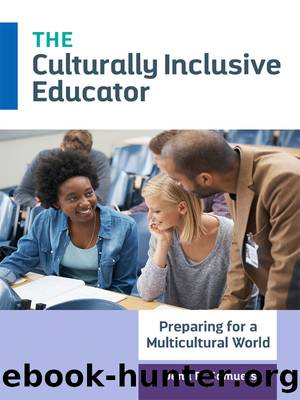The Culturally Inclusive Educator: Preparing for a Multicultural World by Dena R. Samuels

Author:Dena R. Samuels
Language: eng
Format: epub
Publisher: Teachers College Press
Published: 2014-06-14T16:00:00+00:00
Roy also suggests, as other scholars have, that mentoring junior faculty paves the way for retention of members of traditionally marginalized groups, and that mentors should be rewarded for their time, effort, and service through the tenure and promotion process. Further, she acknowledges the challenging role, specifically, that faculty of color face. Their expected contributions to campuses range from serving on search committees to mentoring students of color to championing diversity and inclusiveness issues on campus, all while teaching and doing research. These obligations must be kept to a minimum, especially when a faculty member is working toward tenure.
Active recruitment of educators with traditionally marginalized identities from college, master’s, and doctoral programs is another effective inclusiveness initiative. Finally, Roy argues for “cluster hires”: Hiring two or more faculty members from traditionally marginalized groups makes it more likely that they will stay at the institution. Often, these faculty members leave in favor of a more diverse community. With critical mass comes a cultural shift of an organization that serves to welcome and retain a diverse membership.
What would an inclusive educational institution look like? One way we know we have reached success is if we can honestly say we have created, as Chrobot-Mason (2003) describes it, “a comfortable, non-threatening environment” for all (p. 7). This could be assessed through climate surveys of the entire organization—in other words, not just assessment of students, but also of faculty and administrators. A standard would need to be put in place to determine where the organization stands currently and what the organization ideally expects. The images on the walls in classrooms, offices, and hallways would reflect diverse students, faculty, and staff members. The physical space would have wide hallways and doorways to accommodate anyone who needs more room. The buildings would incorporate gathering areas with chairs and/or sofas to encourage relationship building. The website for the institution would include a link on its homepage to a well-managed diversity and inclusiveness page. Signs around the building or campus would advertise the many multicultural activities going on. And the list goes on. In the following chapter, we will consider the factors that challenge inclusiveness and some of the strategies educators can use to build multicultural environments and relationships.
Download
This site does not store any files on its server. We only index and link to content provided by other sites. Please contact the content providers to delete copyright contents if any and email us, we'll remove relevant links or contents immediately.
| Behavioral Disorders | Communicative Disorders |
| Gifted Students | Inclusive Education |
| Learning Disabled | Mentally Disabled |
| Physically Disabled |
The Art of Coaching Workbook by Elena Aguilar(48039)
Trainspotting by Irvine Welsh(20045)
Twilight of the Idols With the Antichrist and Ecce Homo by Friedrich Nietzsche(17703)
Fangirl by Rainbow Rowell(7827)
Periodization Training for Sports by Tudor Bompa(7324)
Change Your Questions, Change Your Life by Marilee Adams(6637)
This Is How You Lose Her by Junot Diaz(5753)
Grit by Angela Duckworth(4729)
Red Sparrow by Jason Matthews(4654)
Asking the Right Questions: A Guide to Critical Thinking by M. Neil Browne & Stuart M. Keeley(4566)
Paper Towns by Green John(4164)
Room 212 by Kate Stewart(4099)
Ken Follett - World without end by Ken Follett(3968)
The Sports Rules Book by Human Kinetics(3581)
Housekeeping by Marilynne Robinson(3396)
The Motorcycle Diaries by Ernesto Che Guevara(3325)
Introduction to Kinesiology by Shirl J. Hoffman(3297)
Exercise Technique Manual for Resistance Training by National Strength & Conditioning Association(3286)
Double Down (Diary of a Wimpy Kid Book 11) by Jeff Kinney(3267)
